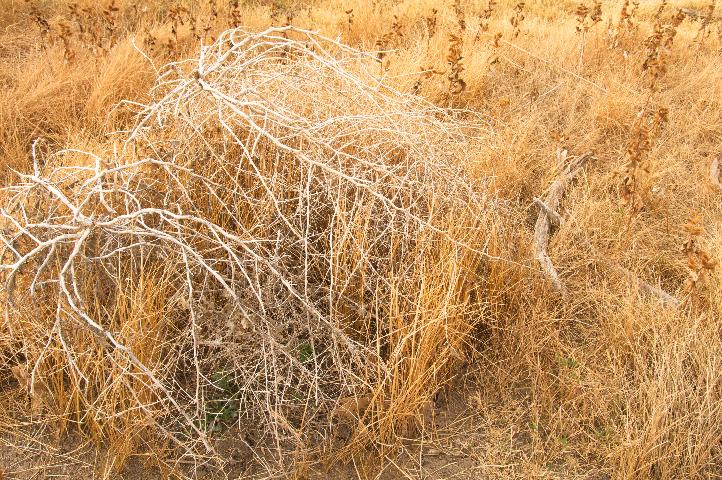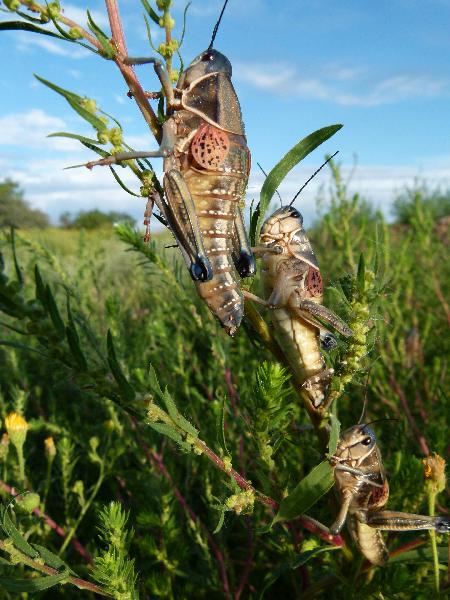Drifting along, like a tumbling tumbleweed. That catchy tune warbled by the Sons of the Pioneers somehow epitomizes nostalgia for the Old West. Never mind that the tumbleweed is a carpetbagger, an interloper, an émigré otherwise known as Russian thistle. I’ve heard tell that the Russkies sent it here as a kind of biological weapon, a plague on our plains, a prickly infestation designed to lay waste to our grasslands, to overwhelm us with its ability to take any of our attacks against it and come back stronger than ever. Where is the real truth here?
As an ecologist, I am always suspicious of introduced species. What are they outcompeting? What natives suffer at the advancing wave of heavily armed hordes of aggressive Salsola?
I admit that secretly I admired the plant’s ability to colonize abused landscapes, its capacity to go tumbling along dropping off babies as it goes. Instead of letting the wind blow its seeds who-knows-where or trusting that some hairy animal will wittingly or unwittingly transport its progeny, the tumbleweed itself is the vehicle that goes bouncing across the landscape, casting propagules along the way as Johnny Appleseed might have done with apples (and when do we ever criticize him for having done so?).
Several states list Salsola as a noxious weed (the very worst kind), forbidden and prohibited for humans to transport or allow to exist. That hasn’t stopped it, of course, but it shows just how much we officially despise it.
Two decades ago I started taking my Wetlands students to Hassayampa River Preserve, a Nature Conservancy preserve near Wickenburg, Arizona. TNC in 1986 bought a five-mile perennial stretch of river just before it might have become a gravel operation.
Frankly, the place was a mess. Palm Lake (an artificial pond created by earlier generations who dug out a rich cienega or spring-fed marshland) was surrounded by trailers and RV’s, the ground pounded into meek submission by human traffic (not trafficking) of all kinds. The river bed had become an informal racetrack, ripped to sandy shreds by thousands of treads. Only a few old trees still lined the river channel.
The state director of TNC, Dan Campbell, had vision, for by removing the stressors (keeping vehicles and cows out), they allowed a miraculous recovery that today is one of the best examples of Fremont cottonwood/Goodding willow forest in the entire Southwest.
But when the trailers had been removed, the abused landscape began to sprout Russian thistle. Not needing a healthy soil with those fungal associates (mycorrhizae) depended upon by most plants, the tumbleweeds took over, huge spiny bushes packed together like an armored fence. Impossible to walk through.
What would you do if you were trying to manage this landscape for ecosystem recovery and public use? Clearly, the weeds were an eyesore, a physical barrier. Is this the best TNC could do by taking over this landscape—turn it into a Russian thistle farm?
The logical impulse would have been to attack the vegetative vermin, hit ‘em with choppers or loppers or plows or weed-whackers. That’s what they do with another unwanted alien, tamarisk or salt cedar. Tammy-whacking parties give well-intentioned volunteers annual opportunities to turn their specific phytoxenophobia into muscle-building, pore-cleansing physical outlet for nature purists. Save the planet, after all.
But ignorance can be a dangerous thing. TNC has nature preserves all over the country, and they have real scientists, not just tree-hugging bureaucrats. Some of those scientists were engaged in studies of invasive species to determine what best strategies might be. After literature review and experiments, they were able to produce a white paper (I’m not certain that it was post-consumer recycled waste or that it incorporated Salsola fibers) on Russian thistle, just as they did for other suspect species.
Lo and behold, the recommendation was simple—cease and desist! Do not attack that tumbleweed; leave that nasty thicket alone. The more you attack them, the better they thrive. Left alone, they will choke themselves out. Yes, success in holding ground spells their doom. I can almost hear them pleading to be whacked, pulled up, discarded. That’s just the kind of attention under which they thrive. Neglect them (the hardest thing for a would-be restorationist to do). Let them live their fairly short lives, sometimes locked together in a fatal embrace that will keep them from taking their babies for a ride. Then they should disappear. Those are not the exact words, but the implication was clear.
TNC gave me a copy of their paper. I was skeptical. That wall of tumbleweed looked incredibly formidable; how could leaving them alone—yielding territory to the enemy without a fight—be better than attacking with a hoe or some other weapon of biomass destruction?
I returned each September with another Wetlands class. To my amazement, within a couple years, the tumbleweeds were all gone. All! A low cover of bermudagrass provided protective ground cover, and it was easy for us to walk under the mesquites that had come in since 1986.
I also realized that the tumbleweeds, Russian émigrés or not, had performed a vital ecological function. They had covered the bare, denuded ground. They had protected it from rainstorm, wind, and trampling animals. They had been like a scab that covers a wound, allowing it to heal. They were a part of the recovery process, a necessary step in succession to a state of grace that we could live with and value.
My students recently saw this site. There was not a clue visible anywhere of the thicket of tumbleweed that had been there—only my vivid memory. Looking at that landscape at this point in time would have told us nothing about the history of resilience and recovery that did occur here. History that might humble us a little. History that might temper our hubris. Invisible now, those once-abundant tumbleweeds were, yes, history.
Today I hiked a fairly new trail near Prescott. As I left the parking lot, I passed a swarm of tumbleweeds on ground that had been torn up, violently disturbed, within the past year or so. I looked at those weeds with more appreciative eyes than I would have in the past. They were covered in plains lubber grasshoppers, Brachystola magna, insects consuming and transforming this biofuel into their colorful bodies, giving them the resources for making their own babies.
As we mature in ecological understanding, we become more aware that our initial judgments are often colored by our prejudices. It is easy to “other” the “alien” plant or animal, just as we other people who are different from us. Our language supports this. Calling a fellow human an “alien” or “illegal” gives us some implied moral authority to reject it, punish it, destroy the “problem.”
Matt Chew wrote a provocative scholarly article that illustrates how supposedly impartial scientists came to revile and attack another non-native: “The monstering of tamarisk: how scientists made a plant into a problem.” Google it and read his insightful analysis, definitely something to chew on.
Then have a little empathy. Remember that to the Apache, the Cree, the Sioux, the Algonquin, the Inuit, the Navajo, the Stillaguamish, the Nootka, the Hualapai, and so many others, we are the tumbleweeds that came unbidden to the New World, already diversely peopled. Alien is as alien does.



Great grey grasshoppers!
Nice read. Yes, I live in the NEtherlands and to me it is rather tragic how quite a few ecologist have turned this science into an ideology. To me, valueladen wording has no place in science period. You simply cannot prove a value judgement. For fun I asked my GF to take 5 books on the subject of restoration biology, so I was unbiased. I read them meticuously. Not one decribed species that arrived later for what it was: a species that has arrived later. Nor where they once able to correctly describe human influences. Instead of the wording “unnatural” they should have used the wording “antropogenic”. You cannot prove that anything done by mankindis somehow unnatural, undesirable, incorrect in this subject. You can prove that the dispearsal of a seed, plant or in short species was antropogenic.
This science and its followers, in generall, is so biased and also teaches the students to be biased in the same way that an impartial and scientific sound view on them is almost impossible.
Personally, I really dislike any ideology that thinks that killing of plants and animals on massive scales (because of their supposed origin) is a good or necessary thing. I think it is time that these people should assess themselves and their views on living things. It now resembles a xenophobic, unforgiving and extremist ideology with again dire conseqences for their target species…
Gov
Thanks for your thoughts, Gov. Anthropogenic origin is indeed a value-free, defensible phrase that is perfectly descriptive. We always manage based on our desires, it seems, and we should at least be honest about our biases and prejudices. That does not mean that we never intervene; there are certainly cases where the value of native diversity is a justifiable reason for “gardening.” We do not let our food crops go wild with weeds, and the analogy could apply to our “wild gardens.” Ultimately, humility and ecological wisdom should together guide our actions.
Hi Wait,
Thanks for your reply. Well….the very concept of nativeness itself, to my mind, needs to be critically thought of. What is native. Waht does it mean. When is somethign native? When it was here since when. Is somehting native because of its place? Because of its climatological fit (especially interesting in these times of climate change). Because of a (more broad) environmental fit? Who are we to decide? Does nature itself care about nativeness? Is nature far too honest, far too nonjudgemental and too just for us humans, as it applies the same rules to each and every individual: you survive or not because you are fit enough or not? Is that pricniple may be too hard to swallow for us humans? Also: is it the role of scientists to research and come up with verifiable facts or is it the role of scientists to act upon their personal values? I think the latter is a very slippery slope. It is not the role of a scientist. Scientists also, to my mind, should observe changes and note them. And get a hol don themselves and not intervene. Also, when they talk about a development they should not let fear get the better of them and be honest about developments. Because ecologist are poor at modelling changes and predicting outcomes of newcomers.
So in conclusion: it is not the role of scientists to passmoral judgements. That is the role of a society as a whole. The role of a scientist is to gather data in a nonbiased, objective way.
I was able to control the tumbleweeds from my yard by pulling them out before Fall time. Before they produce seeds, I pull them by the ROOT. The small ones I use a hula. I also let the native Sage, snakeweed, scorpionweed, & other native plants of my area grow & this seems to deter the unnative russian thistle from growing.